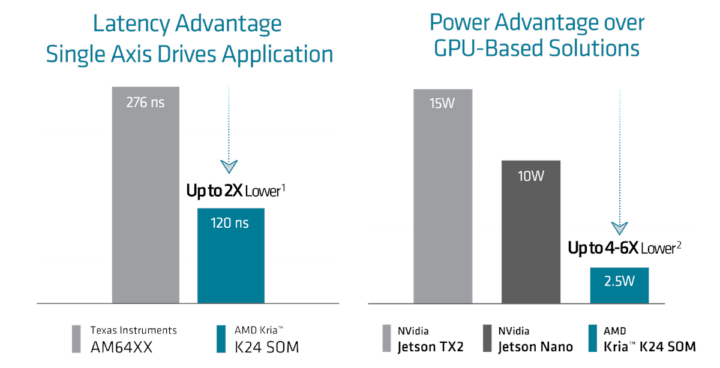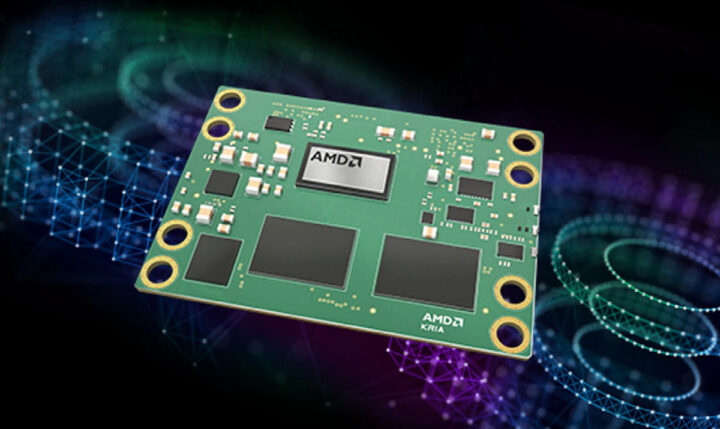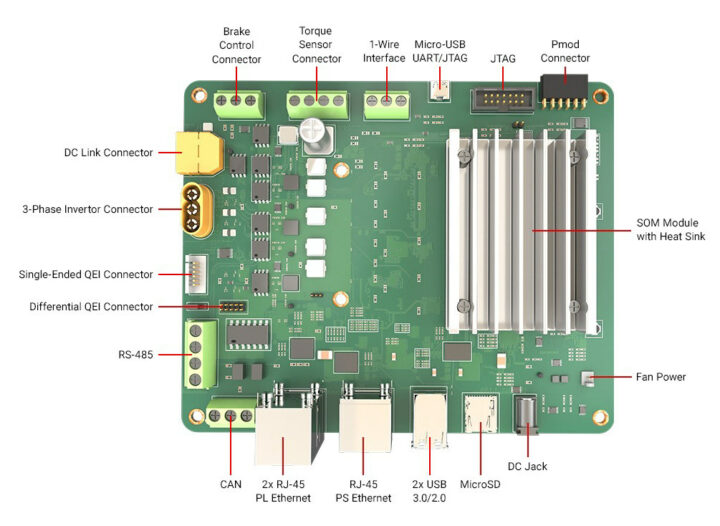The AMD Kria K24 System-on-Module (SOM) with a custom-built Zynq UltraScale+ MPSoC and the KD240 Drives Starter Kit are designed for the development of cost-sensitive industrial and commercial edge applications.
The new Kria K24 is about half the size of a credit card and uses half the power of the larger, but connector-compatible, Kria K26 SOM that was introduced in 2021 for computer vision applications when the company was still known as Xilinx. That means existing K26 carrier boards can be reused with the Kria K24 SOM without modifying the PCB, but note there’s only one 240-pin connector on the new module, plus an extra 40-pin connector.
AMD Kria K24 specifications:
- MPSoC – Custom-built Zynq Ultrascale+ XCK24
- Quad-core Arm Cortex-A53 processor up to 1.3 GHz
- Dual-core Arm Cortex-R5F real-time processor up to 533 MHz
- Mali-400 MP2 GPU up to 600 MHz
- FPGA fabric with 154K logic cells
- AMD Deep Learning Processor – B2304 DPU with 852 GOPS
- 9.4 Mbit on-chip SRAM (distributed RAM & block RAM)
- System Memory – 2GB 32-bit LPDDR4 @ 1066 Mbps with ECC on industrial-grade module
- Storage – TBD
- 1x 240-pin board-to-board connector and 1x 40-pin board-to-board connector
- Networking – Up to 4x 1 Gbps Ethernet (2x PS GEM, 2x PL GEM)
- Motor Drive & Control – Three-phase inverters, Quadrature encoder, Brake control, Torque sensor interface
- USB – 2x USB 2.0 / 3.0
- Other – CAN, RS-485, GPIOs, etc…
- Security – IEC 62443 standard with hardware root of trust (RSA, AES, and SHA) ; discrete TPM 2.0 device
- Dimensions (with heat spreader) – 60 x 42 x 11mm
- Two versions
- Commercial – 0 to 85°C temperature range, 2-year warranty, 5-year operating lifetime, 10-year availability
- Industrial – –40 to 100°C temperature range, ECC memory support, 3-year warranty, 10-year operating lifetime, 10-year availability

What makes the K24 SOM especially suitable for motor control and DSP applications are respectively its low latency (120 ns) which AMD claims is twice lower than the Texas Instruments AM64x processors, and its high efficiency for DSP processing compared to GPU-based solutions from NVIDIA such as the Jetson TX2 and Jetson Nano consuming only 2.5W of power.
The latency comparison relies on latency results reported by TI for a full control loop implementation on a Texas Instruments TMDS64EVM board using
a Texas Instruments benchmark vs. the latency results of a full control loop implementation using a Field Oriented Control algorithm designed by Qdesys running on the KD240 starter kit. AMD further claims the latency advantage improves up to 7x as the number of motor axes increases. The idle/default power draw was measured with the xmutil platform utility on the Kria K24 SOM while loading a bitstream to the SoM, AMD took the number published by NVIDIA for the default/idle power for the Jetson Nano (10W) and the Jetson TX2 (15W).
The Kria K24 SoM runs Yocto-based PetaLinux or Ubuntu Server 22.04 Linux distributions and supports pre-built HW acceleration with Vitis motor control libraries. Additional apps can be installed from the Kria App Store, and Python and the MATLAB Simulink environment can also be used to program the module and KD240 Drives Starter Kit shown below. More details about the software can be found in the wiki.
KD240 Drives Starter Kit specifications:
- SoM – Kria K24 SOM as described above fitted with a heastsink
- Storage – 512 Mbit QSPI flash, MicroSD card slot both bootable
- Networking
- 2x PL Gigabit Ethernet RJ45 port with time-sensitive networking (TSN) and EtherCAT support
- 1x PS Gigabit Ethernet RJ45 port
- USB – 2x USB 3.0 Type-A ports
- Serial – CAN Bus and RS485 terminal blocks
- Motor control
- Torque sensor connector
- 3-phase motor connector
- Brake control connector
DC Link connector - Single-ended QEI (Quadrature Encoder Interface) connector
- Differential QEI connector
- Expansion
- 12-pin PMOD connector
- 1-wire interface
- Debugging – JTAG connector, micro USB port for JTAG/serial
- Misc – Fan connector
- Power Supply – DC jack
- Dimensions – 124 x 142 x 37 mm
- Weight – 237 grams
Target applications include electric motor systems, robotics for factory automation, power generation, public transportation such as elevators and trains, surgical robotics, medical equipment (e.g. MRI beds), and EV charging stations.
The K24 SOM and KD240 Drives Starter Kit are available to order now, but while the K24 commercial version is shipping today, the industrial version should start shipping in Q4. The Kria KD240 Drives Starter Kit can be purchased for $399 directly on TI online shop or via distributors, and a $199 motor accessories pack may be a useful addition for quick evaluation. Further details may be found on the product page and the press release.

Jean-Luc started CNX Software in 2010 as a part-time endeavor, before quitting his job as a software engineering manager, and starting to write daily news, and reviews full time later in 2011.
Support CNX Software! Donate via cryptocurrencies, become a Patron on Patreon, or purchase goods on Amazon or Aliexpress







